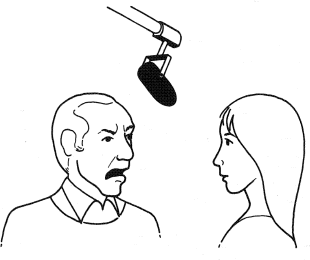Practical Sound Problems
Although audio problems are admittedly the sound specialist’s worry, in the end it is your show that has these imperfections!
Ideal sound
Audio systems have their quirks. They prefer sounds that are not too quiet, for quiet sounds can be lost against background noises. Nor should sounds be too loud for the system, or they will distort, or appear out of scale. So the sound specialist (audio control engineer, sound mixer, sound supervisor) continually monitors audio amplification, adjusting it to keep sounds within the systems’s limits (dynamic range), and ensure that they are in appropriate relative proportions (sound balance). Otherwise, a background sound might inadvertently predominate— or, alternatively, be lost altogether.
Relative volumes
Using a single microphone, problems arise when picking up loud sounds and quiet ones at the same time. Reduce the audio gain to hold the louder sound back, and the quieter may become inaudible. Two separate mikes could be the answer, but that’s not always practicable.
If this dilemma arises when two people are talking together, perhaps the louder person can speak a little quieter, and/or the softer one speak rather louder. The mike might point towards (favor) the quieter voice. It is always advisable to take a voice test (level test) before beginning a recording, if there have been no opportunities to compare relative sound strengths during rehearsal.
A further hazard lies in the mike’s position. If it is badly placed, the volume (level) and quality will change whenever someone turns away, and becomes ‘off mike’.
Distracting sound
Background sounds can be quite distracting. The microphone seems to exaggerate many of the everyday noises around us, that we normally ignore. As well as the all too familiar accompaniment of coughs, footsteps and closing doors, there are the creaks of furniture — wicker chairs and rocking chairs are notorious! Then there is the rattling and jingling of bracelets and bangles. On location one has endless environmental noises to cope with, including telephones, passing aircraft, children at play, and the rest.
Sound and the picture
We need to take care that the volume and the quality of sound is reasonably consistent throughout a scene — particularly when shots are recorded out of sequence. Audio filters (EQ/equalization) can modify sound quality considerably, to increase realism. The same interior must not sound acoustically ‘dead’ in one shot, and very reverberant in the next.
Background sounds should seem continuous; e.g. the sounds of rain, traffic, birdsong, music. Such sounds are regularly added afterwards during post-production editing, perhaps with sound overlays bridging from one scene to the next.
Uneven voice levels
Where quiet voices and loud voices are speaking at the same time the audio system is left at a disadvantage.

Background noise
Where there is a high level of background noise, speech may become inaudibie.

